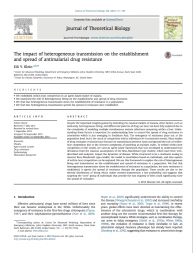January 16, 2014

The Question
How does heterogeneous transmission affect the spread of antimalarial drug resistance?
What we found
In malarious regions, individuals are bitten by infectious mosquitoes regularly. Continuous re-exposure often leads to simultaneous infection with multiple genetically distinct malaria parasites. These parasites compete within the host, which can affect the epidemiological dynamics of the disease, particularly when drug-resistant and drug-sensitive parasites compete. This is exacerbated by heterogeneous transmission, which results in certain members of the community having significantly more within-host competition than others.
By including within-host competition and heterogeneous transmission in our model, we were able to show that heterogeneous transmission slows the rate at which resistance becomes established. This is largely due to drug-susceptible strains out competing resistant strains within the host. However, once resistance in the community is established, heterogeneous transmission speeds the spread of resistance.
Why it matters
Our model has shown that understanding how heterogeneous transmission interacts with within-host competition is important for understanding the emergence and spread of drug resistance. Our findings should encourage additional research into within-host competition, while our model could be extended to include other important components of antimalarial drug resistance such as immunity.

